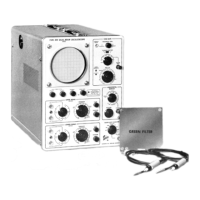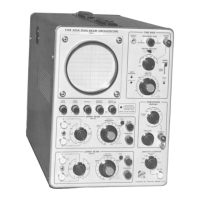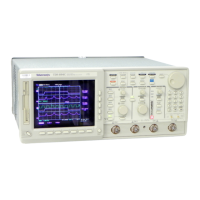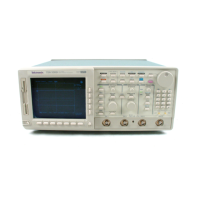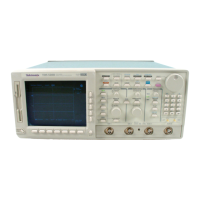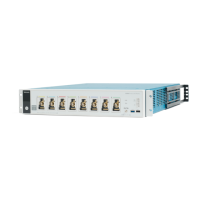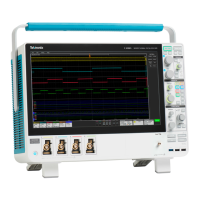g. Check—The display amplitude should be 5 cm ±
1.5 mm.
6. Check Variable Control Ratio— Vertical
a. Requirement— Display amplitude with control in CALI
BRATED position should be >2.5 times the display ampli
tude with the control in full counterclockwise position.
b. Rotate the control fully counterclockwise.
c. Check—Display amplitude should be 2 cm or less,
indicating a ratio of >2.5:1.
d. Return the VARIABLE control to the CALIBRATED posi
tion.
7. Check 1 mV/CM Gain— Vertical
a. Requirement—Vertical deflection accuracy ± 3% .
b. Change the Standard Amplitude Calibrator output to
5 millivolts.
c. Change the VERTICAL SENSITIVITY switch to 1 mV/CM,
and adjust the VERTICAL POSITION control to center the
display, if necessary.
d. Check— Display amplitude of 5 cm, ±1.5 mm (3%).
8. Check .2 VOLTS/CM Gain— Horizontal
a. Requirement— Horizontal deflection accuracy ± 3% .
b. Set the VERTICAL +INPUT selector switch to GND.
c. Set HORIZONTAL +INPUT switch to DC.
d. Set the HORIZONTAL DISPLAY switch to HORIZ.
AMPLIFIER (SWEEP DISABLED).
CAUTION
Whenever the sweep is disabled, check that the
CRT beam INTENSITY control is adjusted to pre
vent damage to the CRT phosphor.
e. Set the Standard Amplitude Calibrator to supply a
1-volt square wave, and connect the signal to the HORI
ZONTAL + INPUT connector.
f. Set the HORIZONTAL SENSITIVITY switch to .2
VOLTS/CM.
g. The display should now consist of two dots spaced
horizontally in the graticule area. Center the display with
the HORIZONTAL POSITION control.
h. Check—The dot spacing should be 5 cm -t 1.5 mm.
9. Check Variable Control Ratio— Horizontal
a. Requirement— Horizontal deflection with the cont/ol
in the CALIBRATED position should be >2.5 times the hori
zontal deflection with the control in the full counterclockwise
position.
b. Rotate the HORIZONTAL VARIABLE control fully coun
terclockwise.
Performance Check— Type 503
c. Check—The dot spacing should be < 2 cm, indicating
a ratio of >2.5:1.
d. Return the VARIABLE control to the CALIBRATED posi
tion.
10. Check 1 m V /C M G ain— Horizontal
a. Requirement— Horizontal deflection accuracy ±3% .
b. Change the Standard Amplitude Calibrator to 5 milli
volts.
c. Change the HORIZONTAL SENSITIVITY switch to 1
mV/CM.
d. Check—Dot spacing 5 cm ± 1.5 mm.
11. Check Compression or Expansion—
Horizontal
a. Requirement— <1.5 mm amplitude change in a 2-cm
display.
b. Change the HORIZONTAL SENSITIVITY switch to .2
VOLTS/CM.
c. Change the Standard Amplitude Calibrator to 0.5 V
output.
d. With the VARIABLE control, adjust the dot spacing
for exactly 2 cm, and center the display horizontally and
vertically.
e. With the HORIZONTAL POSITION control, move the
right-hand dot to the 10-cm vertical graticule line.
f. Check—Dot spacing 2 cm ± 1.5 mm.
g. Move the left-hand dot to the left edge (0-cm) of the
graticule.
h. Check—Dot spacing 2 cm ±1 .5 mm.
i. Return the VARIABLE control to the CALIBRATED posi
tion.
12. Check A m plifier Balance— Horizontal (DC
Common M ode Rejection)
a. Connect an additional 50-ohm cable to the Standard
Amplitude Calibrator output, using a UHF T adapter, and
a quick-connect adapter on the output end of the cable.
b. Set the HORIZONTAL —INPUT to DC, and connect
the cable added in step (a) to the —INPUT connector.
c. Change the Standard Amplitude Calibrator output to
5 volts, and the HORIZONTAL SENSITIVITY switch to .2
VOLTS/CM.
d. The display will be two dots spread horizontally. With
the HORIZONTAL POSITION control, move the display
to the right-hand and then to the left-hand vertical grati
cule line.
e. Check—The total horizontal amplitude of the display
should not exceed 2.5 mm anywhere in the graticule area
(CMRR 100:1).
c)
5 -3
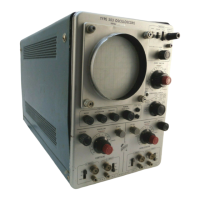
